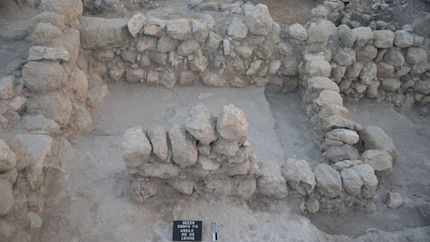American archaeologists discover King Solomon-era palace
They have also found Philistine pottery, lending credence to the biblical account of them living in the city until being vanquished by King David.
Haaretz · JERUSALEM · 02 SEPTEMBER 2016 · 17:10 CET

An archaeological team has discovered a palatial building dating to the 10th century BCE, in the royal city of Gezer, though there is no evidence which of the Israelite kings lived there, if any.
The American team also found a layer featuring Philistine pottery, lending credence to the biblical account of them living in the city until being vanquished by King David.
PALACE FEATURES
The complex features a large central courtyard, like contemporary palace-like buildings found throughout the southern Levant, including at Hatzor and Megiddo. Though there's no telling who ruled from there, if anybody did, the edifice is significantly larger than the size of ordinary houses of the time, excavation co-director Prof. Steve Ortiz, representing the Tandy Museum of Southwestern Baptist Theological Seminary of Fort Worth, Texas, explained.
Among the features not found in usual domestic structures is ashlar masonry - large rectangular-shaped monolithic hewn stones- in the corners of rooms, Ortiz said.
The main feature is two parallel long rooms, or courtyards, surrounded on all sides by various rooms, numbering at least 15. The palace has two entrances from the east and west. The entrance from the west also connects this building to the monumental six-chambered gate associated by most scholars with Solomon. This entrance is more robustly built than the rest of the building.

GEZER, 6000 YEARS OF HISTORY
Gezer, located in the Shephela (foothills) region of Israel overlooking the coastal plain, at the junction of a pass leading up to Jerusalem, goes back way before King Solomon. The site was occupied as far back as the Chalcolithic period (4th millennium BCE), and 3400 years ago, its Canaanite population was closely tied with far-off Egypt, as we know from cylinder seals and a large cartouche of Pharaoh Amenhotep III uncovered there in previous seasons.
Excavations have proven that the city did suffer violent destruction at the hands of the Egyptians, who mention Gezer time and again in their records. Thutmose III recorded its capture on the walls of the temple at Karnak.
The city later played a prominent role in the Amarna Tablets, mentioned by name at least nine times. Pharaoh Merneptah boasted on his stele that he "seized Gezer."
According to the Old Testament, the city was also associated with the Philistines in David's time: the king broke their power “from Geba to as far as Gezer” (2 Samuel 5:25; 1 Chronicles 14:16).
This excavation season has proved the Philistine link too, when the archaeologists revealed a layer with Philistine bichrome pottery. The archaeologists also found a tell-tale fragment of a so-called "Ashdod figurine," long-necked, bird-faced female figures that many believe depict an Aegean goddess. Such figurines have been found associated with Philistine remains in other excavations, such as in Ashdod, Timna, Ekron and Ashkelon.
SOLOMON´S PALACE?
The excavation team calls the building "Solomon’s Palace" because of the biblical tradition of Solomon building grand projects at Hatzor, Megiddo, and Gezer.

The Bible says that Egypt's powerful monarch gave Gezer as a dowry to Solomon’s wife (or one of them) and that Solomon rebuilt the city:
"And this is the reason of the levy which king Solomon raised; for to build the house of the Lord, and his own house, and Millo, and the wall of Jerusalem, and Hazor, and Megiddo, and Gezer. Pharaoh king of Egypt had come up and captured Gezer and had burned it with fire, and he had also killed the Canaanites dwelling in the city. So he gave it as a parting gift to his daughter the wife of Solomon. Solomon built up Gezer" (1 Kings 9: 15-17)
The excavations have uncovered tantalizing evidence that this biblical passage was based on actual events.
The city was destroyed in the late Iron Age I (around 1200-1000) BCE. On the ruins, a new city with fortifications, the famous gate complex, and a palace were constructed, dating to the second half of the 10th century BCE – Solomon's era. The sheer scale and craftsmanship of the palace shows that only a ruler with vast resources and a highly organized and skilled labor forces could afford, let alone organize, the construction of this palace complex.
Published in: Evangelical Focus - culture - American archaeologists discover King Solomon-era palace
